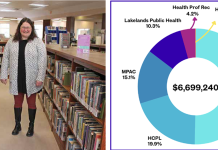After another major drug trafficking investigation led to four more arrests in Haliburton village Feb. 4, Haliburton Highlands OPP interim detachment commander, Mike Cavanagh, said police are investing significant time and resources targeting the illegal narcotics supply in the County.
Approximately 25 officers from the detachment, the Haliburton Highlands and Kawartha Lakes OPP Community Street Crime Unit, and OPP Tactics and Rescue Unit, searched a pair of properties on Highland Street and Pine Avenue earlier this month, confiscating weapons and approximately $50,000 worth of drugs.
Cst. Rob Adams confirmed police seized a CZ P10 nine-millimetre handgun; Mossberg 715T semi-automatic rifle; HK USP .177 handgun; 194 rounds of ammunition; 409.2 grams of cocaine; 369 hydromorphone pills; 152.6 grams of hash; 5.115 litres of GHB; 500 milligrams of anabolic steroids; 55.6 grams of illicit cannabis; 57 packages of 3,000 milligram illicit cannabis gummies; a cocaine brick press; scales, packaging and vacuum sealer; and $3,355 in cash.
“There were all kinds of products seized – for GHB, that’s the most I’ve ever seen in one place in my whole career,” Cavanagh said. Four people were arrested, with two charged. Shawn Harding, 37, of Haliburton was charged with: three counts of possession of a schedule one substance for the purpose of trafficking; two counts of careless storage of a prohibited or restricted firearm; two counts of unauthorized possession of a prohibited or restricted firearm; two counts of knowledge of unauthorized possession of a firearm; possession of loaded prohibited or restricted firearm; possession of a firearm knowing serial number has been tampered with; possession of property obtained by crime under $5,000; and two counts of possession of cannabis for the purpose of selling.
Second major drug bust of the year
Amy Harman, a 43-year-old Algonquin Highlands resident, was charged with possession of a schedule one substance. Cavanagh confirmed she has since been released, but Harding remains in custody.
The charges have not been proven in court. This was the second major bust of the year, following a raid on a multi-unit property on George Street Jan. 21. Multiple firearms, ammunition, knives and drugs were seized following that investigation, which led to the arrest of 41-year-old Dysart resident Brian Reid. Police confirmed Reid remains in custody awaiting a court hearing. His charges have not been proven in court.
On the rise
Despite seeing a spike in drug-related charges last year – 17 in 2024, up from five in 2023 – and eight already this year, Cavanagh insists police aren’t doing too much differently.
“These things are very cyclical – some years we have a lot of cases, sometimes we don’t. It mostly depends on the quality of information we’re receiving,” the chief said. “Each [drug] investigation is a 10-out-of-10 in terms of importance and priority… drug use is a plight in communities.
“We all see the visible signs of addiction – but the invisible signs are the suffering people go through, that families have to endure… these issues have multiple layers, it’s social, health, judicial all wrapped into one,” Cavanagh added.
He said investigatons, “could range from one day to over a year in length. Drug investigations often are not going off physical evidence. It’s going off belief. Officers have to corroborate everything – they have to go to a judge to get orders and follow a very strict process.”
He said the average time spent per drug-related investigation is 80.5 hours, compared to 3.5 hours for standard criminal code calls.
Process in place
Cavanagh said drug investigations routinely require assistance from several officers.
“They’re very resource-heavy… it’s not like in the movies, where you have a couple of officers parked in a car on a stake out. We can’t always have people at one site monitoring, we don’t have the manpower for that,” he said. “Sometimes, we’re completely reliant on what we hear from the community.”
That was the case with the January arrest, where police corroborated with County non-profit Places for People (P4P), which owns the George Street building, and at least one civilian.
Cavanagh said the public plays a major role in helping to rid the community of illegal activity, though noted services like Crimestoppers, which allows for anonymous reporting of suspected crimes, “aren’t utilized to their full potential in this area.”
While recognizing police are never going to completely eradicate illicit drug supply in the Highlands, Cavanagh said they will continue chipping away.
“Elimination is never a focus – that’s extremely difficult, almost impossible when the supply chain exists… often, these people are part of a wider scheme, so we don’t get rid of the problem, we just disrupt it,” he said. “We haven’t seen or noticed any [positive] results come through yet… these people are connected, it’s likely others [take their place]… and users will migrate to purchase what they want and need elsewhere.
“But it’s important for us to address the drug issue in our community. We will keep investigating… we don’t do this to ruin lives, like some of those who end up on the wrong side think – it’s to save lives,” Cavanagh said.





